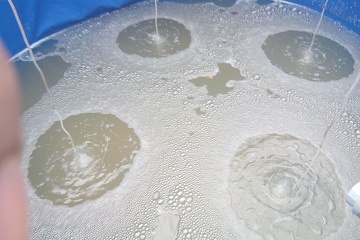Peneliti IPB Teliti Efek Bioflok terhadaAnchorp Kinerja Reproduksi Ikan Nila

In the cultivation of intensive stocking fish (intensive), water quality is very important to be maintained. One of the efforts is through biofloc technology. The biofloc technology (BFT) utilizes bacterial biomass to convert ammonia waste to a harmless form to be used by biota. This biomass can be harvested as a source of fish food, resulting in nutrient recycling and efficient use of nutrient feed.
Julie Ekasari, Muhammad Zairin Jr., Dian Utami Putri, Nora Putri Sari and Enang Harris Surawidjaja from the Department of Aquaculture, Faculty of Fisheries and Marine Sciences, Bogor Agricultural University (FPIK IPB) and Peter Bossier from Ghent University, Belgium conducted research to examine the effect of biofloc technology on the reproductive performance of tilapia Oreochromis niloticus.
The experiment was conducted at the Field Laboratory of the Department of Aquaculture, IPB. Eight units of outdoor concrete tank with dimensions of 3 meters x 2 meters x 0.7 meters were filled with 3 cubic of water. The control container and BFT treatment were randomly determined.
The fish used with average length (ABL) and mean weight (ABW) of 16.7 centimeters and 85 grams was stocked with a density of 20 fish per cubic meter in the ratio of male:females 1:4. Molasses (44 percent Celsius degrees) added to the BFT processing tank as an external carbon source with estimated C:N ratio 15. Fish was fed twice daily with commercial feed (30 percent protein).
Furthermore, the researchers collected four females (16 fishes per treatment) randomly from each tank every two weeks to measure gonadosomatic index (GSI), hepatosomatic index (HSI), fecundity (egg number) and egg diameter. The gonadosomatic index represents the ratio between gonad weight and fish weight, whereas HSI represents the proportion of fish weight.
From the observation it was seen that higher ABW obtained at BFT treatment, and fish grew better in this environment. While at HSI there was no significant difference, these low parameters in both treatments indicated that the energy reserves in the liver were mobilized for gonadal maturation. Until 56th day, the female parent gonadosomatic index at BFT appeared to be rising and peaking at 4.01 percent, and relatively constant thereafter at about 3 percent. The egg diameter in the BFT treatment differed significantly during the trial period. Fish fecundity was also higher in BFT treatment. This was reflected in the total amount generated during the 84-day trial, which was 65 percent higher than in controls.
Blood glucose levels in BFT treated fish continued to rise higher than controls, and differed significantly on days 42 and 56 with values ??of 71 mg.d/L and 85 mg.d/L in control while at BFT 93 mg.d/L and 105 mg.d/L. The observed blood glucose values ??showed higher availability of energy for fish in BFT media. Blood cholesterol levels also proved to be consistently higher in BFT treatment. These researchers explained that cholesterol is a precursor for the biosynthesis of steroid hormones, and also functions in reproduction such as testosterone, estrogen and progestogen. Higher blood cholesterol levels in the BFT treatment can support the improvement of reproductive performance of the parent.
"Biofloc contributes as a potential food source, not only supporting the parent reproduction, but also the survival and development of the resulting larvae. Biofloc not only contains a large enough protein, but also HUFA and vitamin C needed in gonadal maturation and the quality and quantity of eggs. The results of this study indicated that the application of BFT can effectively improve the reproductive performance of tilapia. Biofloc production can be suggested as a way to increase the production of tilapia seeds, "she explained. (TK)



